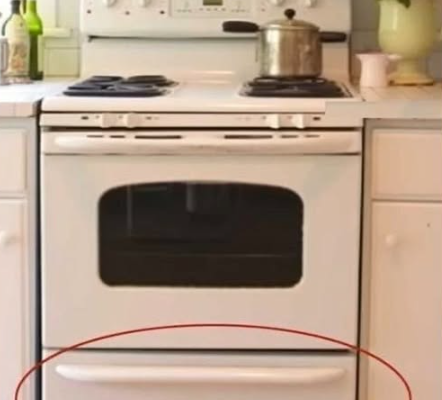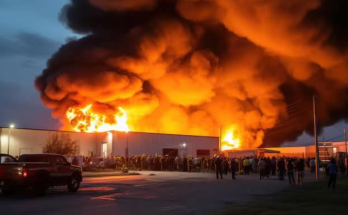Most Folks Get This Wrong: What the Drawer Underneath Your Stove Is Actually Used For
It’s one of those household mysteries that nearly everyone encounters but few ever question: that shallow drawer located directly beneath the oven. For many families, it has served as a convenient hiding spot for cookie sheets, baking pans, and even stray pot lids. In some homes, it’s a cluttered mess of mismatched utensils and forgotten bakeware. But here’s the surprising truth—most people have been using it wrong all along.
That drawer beneath your stove was never designed as storage. Its real purpose, depending on the model, may shock you.
The Hidden Function
On many modern stoves, particularly gas and electric ranges, the bottom drawer is actually a warming drawer. Its intended use is to keep cooked food warm while you finish preparing the rest of your meal. The drawer draws on residual oven heat or its own low heating element to maintain a consistent temperature—warm enough to prevent your roasted chicken or lasagna from going cold, but not hot enough to continue cooking it.
Think about Thanksgiving or Christmas dinner: the turkey comes out of the oven hours before the sides are finished, or the pie is ready while you’re still mashing potatoes. Instead of reheating everything later, the warming drawer can keep it all perfectly warm until it’s time to serve.
Yet, ask around and you’ll find that a surprising number of people had no idea. They grew up watching their parents use the drawer as a storage cubby, and the habit carried on.
Why the Confusion?
Part of the misunderstanding stems from the fact that not every oven drawer is the same. On some older models, especially decades-old gas stoves, the drawer truly is meant for broiling. These broiler drawers are designed to cook food quickly under high direct heat—perfect for searing steak or browning casseroles. If you ever noticed the slot beneath the oven glowing bright red when turned on, chances are you’ve encountered a broiler drawer.
On more modern ranges, however, the drawer’s purpose shifted to warming. Manufacturers quietly made the change, but consumer habits didn’t catch up. And since appliance manuals are among the least-read documents in most households, generations of people have simply assumed the drawer was nothing more than a glorified storage box.
The Dangers of Storing Pans There
Although countless households still stash their baking pans down there, appliance experts warn it’s not always safe. If your drawer is truly a warming or broiler drawer, the high heat could warp your pans, damage plastic handles, or even create a fire hazard if flammable items are accidentally stored. Many people have learned this lesson the hard way, opening the drawer to find melted spatulas or scorched baking sheets.
Manufacturers recommend keeping the drawer clear for its intended function. If you absolutely must store items there, stick to metal bakeware and avoid plastics, paper, or wood.
How to Tell What Kind of Drawer You Have
So, is your stove’s bottom drawer a storage space, a broiler, or a warmer? The easiest way to know is to check the owner’s manual or look up the model number online. If you can’t find the manual, there are some simple clues:
-
If it has a heating element inside (often visible when you peek in), it’s probably a broiler.
-
If it has a control setting on the range labeled “Warming Drawer” or “Keep Warm,” then it’s designed for warming.
-
If it looks like a simple empty cavity with no heating elements, it may just be a storage drawer.
In other words, not all stove drawers are equal, and understanding your own appliance can make cooking easier—and safer.
Everyday Uses for the Warming Drawer
If your drawer is in fact a warming drawer, it can be more useful than you realize. Consider some of these practical applications:
-
Family Dinners – Keep dishes hot while waiting for late family members.
-
Holiday Meals – Perfect for juggling multiple side dishes without everything going cold.
-
Bread Proofing – The gentle, consistent warmth makes it a great environment for yeast dough to rise.
-
Warming Plates – Restaurants serve meals on warm plates for a reason: food stays hot longer. You can do the same at home.
-
Slow Cooking – Some warming drawers have temperature controls that allow low, slow cooking of casseroles or braises.
Suddenly, that “extra storage bin” becomes a highly practical kitchen tool.
A Peek at History
The concept of warming drawers isn’t new. In fact, their earliest versions appeared in wood-burning stoves of the 19th century. Back then, the area beneath the oven chamber naturally stayed warm after cooking. Cooks would slide biscuits, pies, or breads down there to keep them from cooling too quickly.
As ovens evolved into gas and electric ranges, manufacturers deliberately incorporated warming or broiling drawers to replicate this function. Over time, however, as kitchens grew crowded with gadgets and cookware, people began treating the space as bonus storage instead. The original purpose slowly faded from public memory.
Why It Matters
At first glance, it might seem trivial whether you use the drawer for storage or warming. But knowing its actual function can elevate your cooking and reduce stress in the kitchen. Imagine finishing all your dishes without rushing to serve everything at once, or baking bread with perfectly proofed dough thanks to the drawer’s gentle warmth.
There’s also a safety factor: if you’ve been storing plastic mixing bowls, parchment paper, or other flammable items in your drawer, discovering its true purpose could prevent a future accident.
The Broader Lesson
The mystery of the stove drawer teaches a larger lesson about everyday appliances: many of us use them without truly understanding their design. Microwaves, dishwashers, washing machines—each has hidden features or functions most owners never discover. By reading manuals or exploring settings, we often unlock time-saving or life-improving tricks.
The drawer under the oven is a perfect example. A simple shift in knowledge can transform it from a cluttered storage spot into a versatile kitchen helper.
Conclusion
So, the next time you glance at your stove’s bottom drawer, remember: it may be far more than a place to stash baking sheets. It could be a broiler for searing, a warming drawer for keeping dinner hot, or, in some cases, just storage—but you won’t know until you check your model.
Most folks get it wrong because we inherit habits from our parents or assume we know what something is for. But understanding the drawer’s true purpose can change the way you cook, simplify your meals, and even keep your family safer.
That unassuming drawer isn’t just wasted space—it’s a hidden feature waiting to be put to good use.

